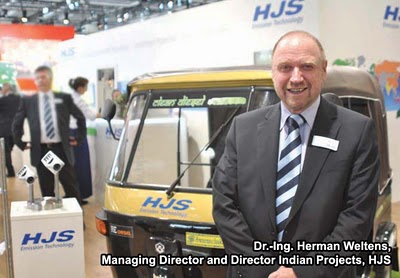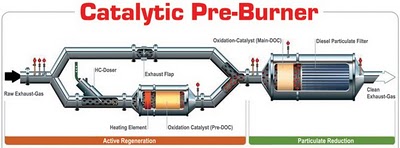 HJS Emission Technology, a leading global manufacturer of exhaust-gas aftertreatment technologies, based in Germany, has announced plans to set-up a manufacturing facility in India. The company has recently established a sales and procurement office in Bangalore.
HJS Emission Technology, a leading global manufacturer of exhaust-gas aftertreatment technologies, based in Germany, has announced plans to set-up a manufacturing facility in India. The company has recently established a sales and procurement office in Bangalore.The strategic plan of HJS Emission Technology is to have a manufacturing facility in India by the second half of 2011. The initial focus will be to manufacture particulate filters for diesel engines. The company is considering the Pune area as one of the possible locations for setting up its manufacturing facility.
The sales and procurement office in Bangalore will manage and look after all of its existing and potential customers in India and will source components from Indian suppliers for the German operations. HJS is already closely working with Indian OEMs and has developed solutions to meet BS IV legislation for companies such as Eicher and Swaraj Mazda. Additional projects with other OEMs are being worked on. HJS philosophy is to support their customers over the development and the entire life span of the product in all aspects of reducing diesel engine emissions. For the actual needs of the Indian market HJS is offering an after treatment system with a specially developed particulate filter for effective soot reduction.
Now that we more fully understand the impact of pollution on the human body and the environment in general – particularly in mega cities – and in light of the amazing rates of growth in industrial output and mobility as well as the associated dramatic increase in energy consumption on the subcontinent, the challenge of reducing overall emission pollution is immense. The Indian Government has introduced legislation similar to that enacted in Europe, initially starting with stage BS I in 2000. In April 2010, BS IV came into force, laying down emission levels aimed at alleviating the conflict of interests between a country in the process of developing and the necessity of protecting the environment. As of April 2010 Indian emission legislation requires the installation of exhaust-gas aftertreatment systems in motor vehicles in use in the National Capital Region (Delhi) and 12 mega cities, with the same restrictions being most likely applied nationwide by 2014/2015. This will affect all 3- and 4-wheelers as well as trucks and buses alike.
The initial legislative goal of BS III to BS IV is to reduce particulate matter (PM) emissions by about 80%. The strict particulate limits for Light (LCV) and Heavy Commercial Vehicles (HCV) of 0.020 g/kWh, together with the NOx level of 3.5 g/kWh for commercial vehicles that came into force in April 2010 for the mega cities and that will be extended nationwide in the years 2014/2015 at the latest, can already be met today with the use of HJS technologies.
The filter technology consisting of a Diesel Oxidation Catalyst (DOC) and a Partial Flow Filter linked with engine mounted Exhaust-Gas Recirculation (EGR) can be applied to existing engines with low-cost mechanical fuel injection or common rail systems. This concept prevents clogging of the filter and therefore the risk of possible malfunctioning. It guarantees a fail-safe and long-life particulate filter solution while minimizing costs and providing greater design freedom in comparison to other principles of particulate filters. Besides solutions to reach BS IV targets for the Indian market HJS Emission Technology is also offering emission solutions to meet the even more stringent limits set down by Euro 5/6 for on-road vehicles and Tier 4 final for non-road machinery.
Besides solutions to reach BS IV targets for the Indian market HJS Emission Technology is also offering emission solutions to meet the even more stringent limits set down by Euro 5/6 for on-road vehicles and Tier 4 final for non-road machinery.
Independent thermal management
A key challenge for systems designed for the reduction of emissions, such as particulate filters and denox systems, is the thermal management of the exhaust-gasses. Technologies for reducing pollutants require a specific exhaust-gasses temperature to trigger the necessary chemical processes. However, commercial vehicles and non-road applications often cannot reach these temperatures on their own due to their variable load profiles. HJS has therefore developed innovative systems that heat up the exhaust-gas with the help of an integral single or multi-stage flame burner. For larger engines, this can be supplemented by an additional HCI (hydrocarbon injection) unit to increase efficiency even more. A diagnostic function monitors and controls the burner. If more oxygen is needed, the so called E-Booster can be used to supply extra air. Uniquely, the HJS burners operate independently of the exhaust-gas temperature and are therefore ready for use at any time – even when the engine is idling. They are also extremely robust and low maintenance.
As an alternative, HJS has also developed the world’s first electro-thermal version: the catalytic pre-burner (KVB). The KVB generates the required exhaust-gas temperature by using electrical energy in a pre-catalytic converter – no flame or oxygen supply is needed. “The KVB is simple to operate and has excellent cold-starting ability,” explains Michael Himmen, member of the board of management at HJS Emission Technology. “It can raise exhaust-gas temperatures even when they are extremely low, allowing our filters and denox systems to function smoothly.”